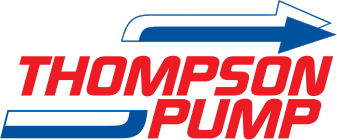Bypass Allows Treatment Plant Conversion into Pump Station
The Pied Creek Treatment Plant, in Kansas City, MO, was being refurbished into a new Pump Station. The treatment plant employed submersible pumps to move the raw sewage, but the submersible’s discharge piping had become corroded and was not directing the sewage properly. Francis Reddy, engineer for Pollution Control, contacted Thompson Pump based upon a previous successful project Thompson Pump worked on with Foley Company, the contractor in charge of the rehabilitation of the pump station.
Mr. Reddy was concerned because the pumps would have to discharge about 150’ away from the pumping site, and into a force main, which could produce as much as 60-psi of backpressure, or “water hammer,” on the pumps. Water hammer occurs when pressure in either the suction or discharge sides of the pump system, is high enough to cause the effluent to stop quickly and “hammers” back into the pump. This hammer-effect could cause severe damage to the pump, and cause the suction or discharge hose or pipe to react violently to the pressure causing it to break, tear, or even become loose from its connection to the pump.
The peak flows of the Pied Creek Treatment Plant were as much as 3,500 gallons per minute. Thompson Pump’s Kansas City representative reviewed the project with Mr. Reddy and proposed using a Thompson Pump 6-inch solids handling compressor-assisted high pressure pump with the Enviroprime System® for the primary pumping. A 12-inch solids handling compressor-assisted high pressure pump with the Enviroprime System® and with an automatic start and stop control panel with flotation device was recommended for back-up duty. Because these pumps were equipped with diesel engines, the speed of the pump could be accelerated gradually, which would help protect the system against the backpressure from the force main.
Each of the pumps were equipped with Thompson Pump’s exclusive Enviroprime System®, which has been proven to be a valuable addition to any bypass application. By design, the Enviroprime System® prevents the pumping effluent, in this case, sewage, from escaping from the priming system and causing an environmental concern. It also is able to prime and re-prime quickly, even in “snore” conditions (when a pump’s suction strainer is no longer submersed in the water and pulling is in air).
The Thompson pumps with all of the necessary connections were supplied to the Pied Creek plant and Thompson Pump also supplied and fused 200’ of High Density Polyethylene (HDPE) pipe for the bypass. The HDPE pipe specifically selected due to the risk of water hammer because it is heavier, more rigid pipe. Because HDPE pipe is tougher, any bracing of the discharge hoses was not required. Also, HDPE pipe is fused, rather than connected, which therefore eliminated the chance of connections leaking or breaking and causing an environmentally hazardous situation. The two pump’s discharges were connected to a common manifold with gate valves to help regulate the flow, and then were discharged into the force main. With the Thompson Pumps in place, “the bypassing worked flawlessly,” reported Mr. Reddy.
